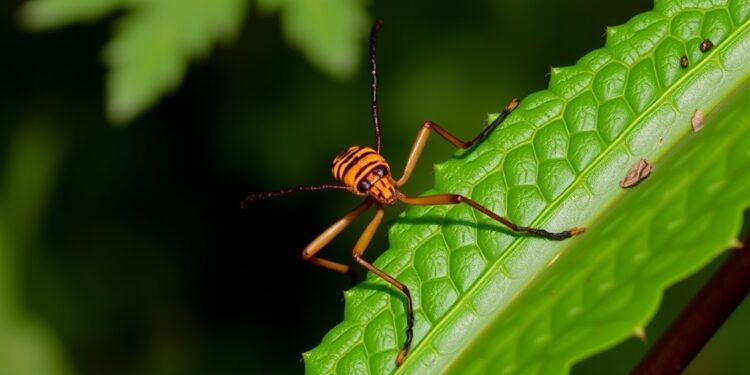
The ongoing evolution of genetic biocontrol technologies has introduced groundbreaking methods to address the mounting challenges posed by insect pests and disease vectors. With the growing resistance to traditional pesticides and the ecological concerns surrounding their use, innovative solutions are imperative to safeguard human and environmental health. The recent study on the toxic male technique (TMT), published in *Nature Communications* by Samuel J. Beach and Maciej Maselko, represents a transformative approach that could redefine pest management strategies. By leveraging genetically engineered males to express venom proteins within their seminal fluid, this method directly reduces the lifespan of mated females, presenting a rapid and effective solution to mitigate the harm caused by pest populations.
Insect pests, including species such as *Aedes aegypti* and *Anopheles* mosquitoes, have long posed significant threats to global health and agriculture. Diseases such as malaria, dengue, Zika, chikungunya, and yellow fever continue to inflict substantial mortality and economic burdens worldwide. For instance, dengue virus alone infects approximately 390 million people annually, earning its designation as the most prevalent vector-borne viral infection globally. Moreover, the annual losses attributed to crop damage by pests and pathogens range between 20% and 30%, with a cumulative economic cost of biological invasions estimated at over $162 billion in damages in 2017 alone. These staggering figures underscore the urgent need for alternative pest control measures that can circumvent the limitations of existing strategies.
Traditional genetic biocontrol technologies, such as the sterile insect technique (SIT) and release of insects carrying a dominant lethal gene (RIDL), have demonstrated varying degrees of success in reducing pest populations. These methods primarily target intergenerational effects by releasing modified males that either sterilize females or propagate genetic traits that lower offspring viability. While effective, these approaches are hindered by a generational lag before noticeable population suppression occurs. This delay is particularly problematic for species where adult females are the primary agents of harm, such as mosquitoes that transmit diseases through blood-feeding.
The TMT offers a revolutionary alternative by functioning intragenerationally—directly impacting the fitness and survival of females that mate with genetically engineered males. This technique involves the heterologous expression of insecticidal venom proteins within the male accessory glands (MAG), which are transferred to females during mating. In the study conducted on *Drosophila melanogaster*, males engineered to express venom proteins reduced the median lifespan of mated females by 37% to 64% compared to controls. The venom proteins, selected for their specificity and stability, target invertebrate ion channels without adversely affecting males or non-target species, offering a highly selective and environmentally friendly pest control solution.
Key to the success of TMT is the precise regulation of venom protein expression. The researchers employed a bipartite GAL4-UAS system to ensure MAG-specific expression, minimizing off-target effects and maintaining the stability of transgenic lines. Among the venom proteins tested, two—Γ-CNTX-Pn1a from the *Phoneutria nigriventer* spider and δ-AITX-Avd2a from the *Actinia sulcata* sea anemone—demonstrated significant reductions in female lifespan without compromising male viability. These findings underscore the potential of TMT as a scalable and effective tool for rapidly controlling pest populations, particularly in response to disease outbreaks.
The study also highlights the theoretical capabilities of TMT through agent-based modeling of an *Aedes aegypti* release program. Simulations compared the performance of TMT to fsRIDL, the current state-of-the-art genetic biocontrol technology, under varying conditions of polyandry, density-dependent mortality, and release ratios. Results indicated that TMT could achieve a 40% to 60% greater reduction in blood-feeding rates during the release period compared to fsRIDL. This reduction has profound implications for curbing the spread of vector-borne diseases, as it directly impacts the primary mechanism of disease transmission.
Despite its promise, the implementation of TMT requires further optimization to maximize its efficacy. The study suggests that improvements in venom protein expression levels, co-expression of multiple toxins, and conditional activation mechanisms could enhance the lethality of TMT males. Additionally, the potential impact of venom proteins on natural predators and the ecological implications of large-scale releases must be carefully evaluated. The researchers also emphasize the importance of developing strategies to prevent transgene escape, such as combining TMT with sterilization techniques to produce non-viable offspring.
The broader implications of TMT extend beyond mosquito control. This technique could be adapted for other pest species with similar life cycles and reproductive behaviors. For instance, TMT may be particularly effective in controlling anautogenous disease vectors like black flies and horse flies or agricultural pests with long-lived and polyandrous females. Its taxonomic specificity and self-limiting nature address many ecological concerns associated with chemical pesticides and other genetic biocontrol methods, making TMT a sustainable alternative for integrated pest management.
The TMT study represents a paradigm shift in genetic biocontrol, offering a rapid and targeted solution to combat the dual threats of insecticide resistance and vector-borne diseases. By leveraging the unique properties of venom proteins and advanced genetic engineering techniques, this approach has the potential to transform pest management strategies and significantly improve global health and food security.
Subject of Research: Genetic biocontrol using recombinant venom proteins in insect seminal fluid.
Article Title: Recombinant venom proteins in insect seminal fluid reduce female lifespan.
News Publication Date: January 2025.
Article DOI References: https://doi.org/10.1038/s41467-025-00000-0
Image Credits: Scienmag
Keywords: Genetic biocontrol, toxic male technique, insect pests, vector-borne diseases, recombinant venom proteins, Drosophila melanogaster, integrated pest management, Aedes aegypti.





